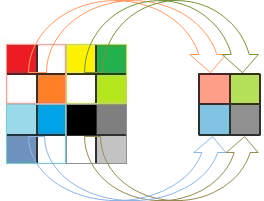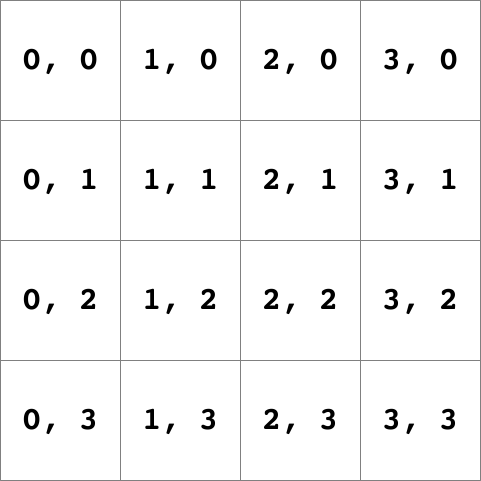EECS2030 Lab 6
Tue Nov 8, Thu Nov 10, Mon Nov 14
Due date:
ALL SECTIONS: Thu Nov 24 before 23:59
Introduction
This lab has you implement four recursive algorithms. You should review the course notes and lecture slides before attempting this lab.
For Questions 1–3, you are given examples that should help you determine the base case(s) and the recursive invocation. For Questions 4 and 5, you need to find the base cases and recursive invocations on your own.
Introduction
Please create a class named Recursion inside the package
eecs2030.lab6
The API for the Picture class that you will be using
in Question 5, and the methods you need to implement for the lab are
here:
The Jar file for Picture is here:
Starter code is here:
Question 4 requires digital pictures as input. You can easily
load the pictures into your program if you place the picture files
in the same directory as the package eecs2030.lab6.
Some test pictures for Question 4 are here:
Question 1: Compute the sum of the first n integers
Computing the sum of the first n positive integers can
be performed by recursive addition.
For example, the sum of the first 6 positive integers could be
computed like so:
6 + 5 + 4 + 3 + 2 + 1 = 6 + (5 + 4 + 3 + 2 + 1) = 6 + (5 + (4 + 3 + 2 + 1)) = 6 + (5 + (4 + (3 + 2 + 1))) = 6 + (5 + (4 + (3 + (2 + 1)))) = 6 + (5 + (4 + (3 + (2 + (1))))) base case
where the expression inside the red parentheses represents a recursive call.
Implement the method sum(int n) that uses recursion to
compute the sum of the first n positive integers
(1, 2, 3, ..., n).
Question 2: Reverse a string
Creating a new string that is equal to the reversal of another string s
can be performed by recursively adding the character at the end of s
to the front of the new string, removing the last character from s
in the recursive call.
For example, the reversal of "banana" could be computed like so:
reverse("banana")
→ 'a' + reverse("banan")
→ 'a' + 'n' + reverse("bana")
→ 'a' + 'n' + 'a' + reverse("ban")
→ 'a' + 'n' + 'a' + 'n' + reverse("ba")
→ 'a' + 'n' + 'a' + 'n' + 'a' + reverse("b")
→ 'a' + 'n' + 'a' + 'n' + 'a' + 'b' + reverse("")
→ 'a' + 'n' + 'a' + 'n' + 'a' + 'b' + "" base case
The base case occurs when the string s has length equal to 0.
Implement the method reverse(String s)
using the recursive algorithm described above.
You cannot actually remove the last
character from a string because strings are immutable;
for a string s you
can obtain the substring containing all the characters of s
except the last element by using substring:
String allButLastChar = s.substring(0, s.length() - 1);
Question 3: Find the minimum element in a list
The minimum element of a list can be found recursively by finding
the minimum of the first element in the list and the remaining
elements of the list (the second element to the end).
For example, consider finding the minimum element of the list
[34, 98, 5, 32, 73]:
min([34, 98, 5, 32, 73]) = min(34, min([98, 5, 32, 73])) recursive call = min(34, min(98, min([5, 32, 73]))) recursive call = min(34, min(98, min(5, min([32, 73])))) recursive call = min(34, min(98, min(5, min(32, min([73]))))) base case, return 73 = min(34, min(98, min(5, min(32, 73)))) return 32 = min(34, min(98, min(5, 32))) return 5 = min(34, min(98, 5)) return 5 = min(34, 5) return 5 = 5
Implement the method public static int min(List<Integer> t)
by recursively finding the minimum of the first element of the list and
the remaining elements of the list. You should not remove the first
element from the list;
for a list of integers t you
can obtain the sublist containing all the elements of t
except the first element by using subList:
List<Integer> u = t.subList(1, t.size());
To find the minimum of two integers you can use Math.min.
Question 4: Downsampling a picture by a factor of 2
A digital picture's resolution is determined by the number of pixels used to create the image. A common operation on digital pictures is scaling the size of the image. Increasing the size of the image is called upsampling and decreasing the size of an image is called downsampling.
Optimal up- or downsampling by an arbitrary factor is an interesting topic that is beyond the scope of first-year computing and mathematics. However, downsampling by factors that are a power of 2 can be performed using recursion to achieve good results.
To downsample a picture by a factor of 2, we can average the color of every
non-overlapping 2x2 block of pixels.
The following image shows how we can downsample a 4x4 picture to produce
a new 2x2 picture:

The arrows show that the color of the pixel in the downsampled picture is the average color of four pixels in the original image. Downsampling the 2x2 picture would produce a 1x1 picture (the original 4x4 picture downsampled by a factor of 4).
Implement the method downsample(Picture p, int n) that downsamples
p by a factor of 2 n times. A precondition of the
method is that the width and height of the picture are both multiples of
2n.
Picture is a class that allows you to load, display, and
manipulate the pixels of a digital picture. The pixels are indexed using
zero-based integer coordinates (x, y) where (0, 0)
is the top-left corner of the picture. Here are the coordinates for a
4x4 picture:

Pixels in a picture are represented using java.awt.Color.
A Color has a red, green, and blue integer component. To average
four colors, you can do the following:
/* for Color references c1, c2, c3, and c4 */ int r = c1.getRed() + c2.getRed() + c3.getRed() + c4.getRed(); int g = c1.getGreen() + c2.getGreen() + c3.getGreen() + c4.getGreen(); int b = c1.getBlue() + c2.getBlue() + c3.getBlue() + c4.getBlue(); Color avg = new Color(r / 4, g / 4, b / 4);
You can create a new Picture from a file by using the
appropriate constructor:
Picture p = new Picture("snowflake.jpg");
Question 5: Binary search
Binary search is a technique that searches for a given element in
a sorted list. Binary search recursively examines the middle element of
the list to determine which half of the list the target element must lie in.
If the searched for element is in the list then binary search should return the
index where the element is located.
Consider searching for the string "m" in the list
["a", "b", "c", "e", "f", "g", "h", "i", "j", "k", "l", "m", "n", "o", "p", "q", "r"]
(notice that the "d" is missing from the list):
bsearch("m", ["a", "b", "c", "e", "f", "g", "h", "i", "j", "k", "l", "m", "n", "o", "p", "q", "r"])
→ there are 17 elements in the list, examine the 9th element and decide which half to recursively search
→ 9 + bsearch("m", ["k", "l", "m", "n", "o", "p", "q", "r"])
→ there are 8 elements in the list, examine the 4th element and decide which half to recursively search
→ 9 + bsearch("m", ["k", "l", "m"])
→ there are 3 elements in the list, examine the 2nd element and decide which half to recursively search
→ 9 + 2 + bsearch("m", ["m"])
→ there is 1 element in the list, if the element in the list is greater than or equal to "m" return 0 otherwise return 1
→ 9 + 2 + 0
→ 11
If the searched for element is not in the list, then binary search should return the index
where the element would be if it were inserted into the list.
Consider searching for the string "d" in the same list as above:
bsearch("d", ["a", "b", "c", "e", "f", "g", "h", "i", "j", "k", "l", "m", "n", "o", "p", "q", "r"])
→ there are 17 elements in the list, examine the 9th element and decide which half to recursively search
→ bsearch("d", ["a", "b", "c", "e", "f", "g", "h", "i"])
→ there are 8 elements in the list, examine the 4th element and decide which half to recursively search
→ bsearch("d", ["a", "b", "c"])
→ there are 3 elements in the list, examine the 2nd element and decide which half to recursively search
→ 2 + bsearch("d", ["c"])
→ there is 1 element in the list, if the element is greater than or equal to "d" return 0 otherwise return 1
→ 2 + 1
→ 3
Implement the method public static int bsearch(String s, List<String> t)
that performs recursive binary search for a string s in an already sorted list
t. You should not modify the list t. Use the
list method subList to get the half of the list that
you need to search for each recursive call.
Submit
Submit your solution:
submit 2030 lab6 Recursion.javaor if you are working in a group:
submit 2030 lab6 Recursion.java group.txt